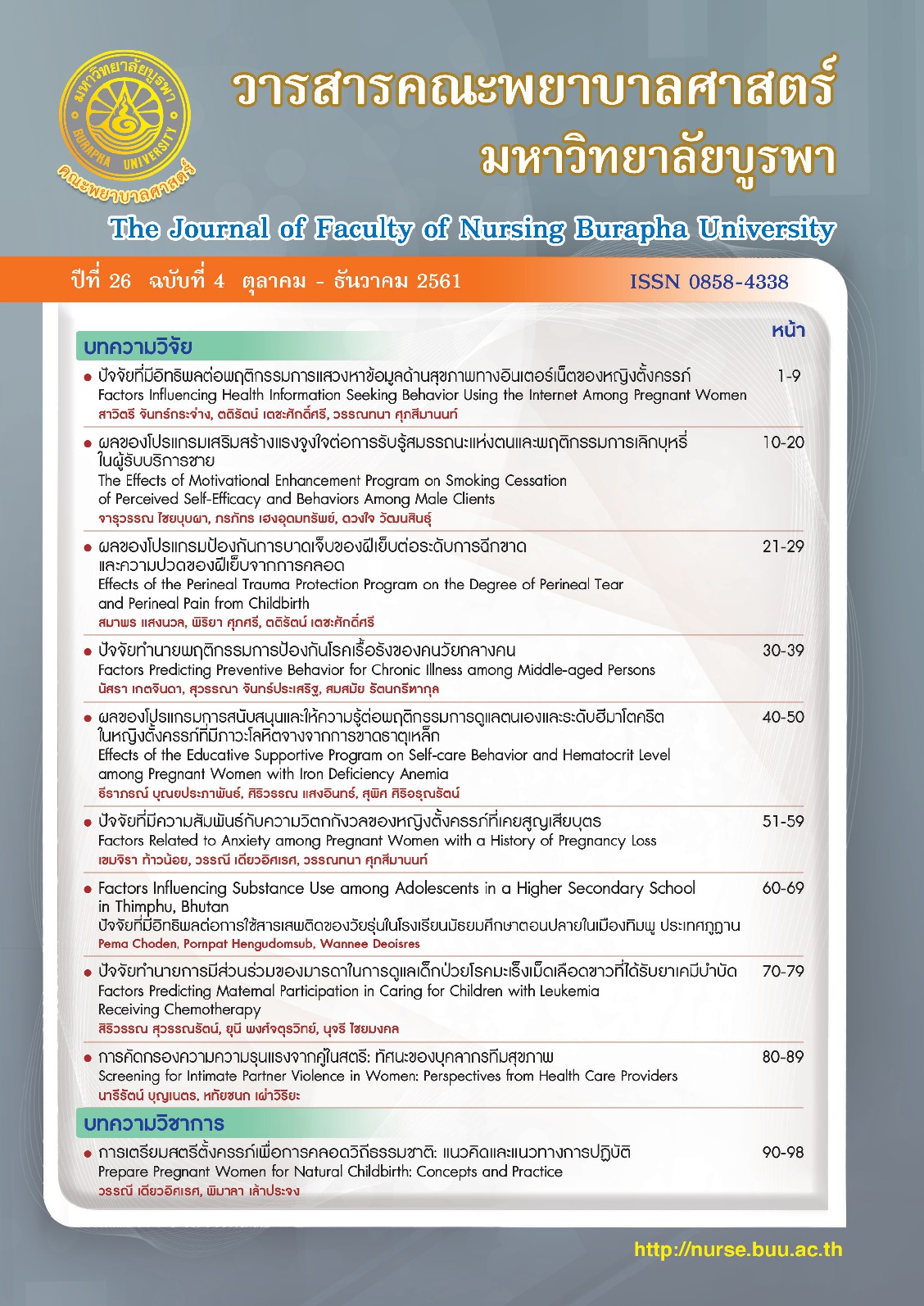ผลของโปรแกรมป้องกันการบาดเจ็บของฝีเย็บต่อระดับการฉีกขาด และความปวดของฝีเย็บจากการคลอด
คำสำคัญ:
โปรแกรมป้องกันการบาดเจ็บของฝีเย็บ, ความปวด, ผู้คลอดบทคัดย่อ
บทคัดย่อ
การวิจัยกึ่งทดลองแบบสองกลุ่มวัดผลก่อนและหลังการทดลองนี้ มีวัตถุประสงค์เพื่อศึกษาผลของโปรแกรมป้องกันการบาดเจ็บของฝีเย็บต่อระดับการฉีกขาดและความปวดของฝีเย็บจากการคลอด กลุ่มตัวอย่างคัดเลือกแบบสะดวกตามเกณฑ์ที่กำหนดไว้ จำนวน 60 ราย เป็นผู้คลอดในโรงพยาบาลแห่งหนึ่ง ในจังหวัดชลบุรี กลุ่มควบคุมจำนวน 30 ราย ได้รับการดูแลฝีเย็บแบบเป็นกิจวัตร และกลุ่มทดลองจำนวน 30 ราย ได้รับโปรแกรมป้องกันการบาดเจ็บของฝีเย็บ เก็บรวบรวมข้อมูลระหว่างเดือนกุมภาพันธ์ถึงเดือนมีนาคม พ.ศ. 2561 เครื่องมือที่ใช้ในการวิจัย คือ โปรแกรมป้องกันการบาดเจ็บของฝีเย็บ แบบบันทึกข้อมูลส่วนบุคคล แบบประเมินระดับการฉีกขาดของฝีเย็บมีค่าความเชื่อมั่นเท่ากับ .92 และแบบประเมินความปวดของฝีเย็บมีค่าความเชื่อมั่นเท่ากับ 1.00 วิเคราะห์ข้อมูลด้วยสถิติพรรณนา การทดสอบ Chi-square และ Independent t-test
ผลการวิจัยพบว่า ผู้คลอดในกลุ่มทดลองมีระดับการฉีกขาดของฝีเย็บน้อยกว่ากลุ่มควบคุมอย่างมีนัยสำคัญทางสถิติ (c2= 20.00, p<.001) แต่ความปวดของฝีเย็บไม่แตกต่างกัน (p>.05) ผลการวิจัยนี้แสดงให้เห็นว่าโปรแกรมป้องกันการบาดเจ็บฝีเย็บนี้มีประสิทธิภาพ พยาบาลผดุงครรภ์สามารถนำไปใช้เพื่อช่วยให้ผู้คลอดมีอัตราการฉีกของฝีเย็บลดลง
เอกสารอ้างอิง
Al-Zein, H. J, Jarrah, S., & Al-Jaghbir, M. (2013). The relationships between obstetric perineal trauma, risk factors and postpartum outcomes immediately after childbirth. International Journal of Childbirth Education, 28(4), 39-44.
Chanwijit, T., & Chawongluang T. (2016). Complication of parturients delivered with or without episiotomy in Krabi Hospital. Journal of the Department of Medical Service 41(5), 108-112. [In Thai]
Elvander, C., Ahlberg, M., Thies-Lagergren, L., Cnattingius, S., & Stephansson, O. (2015). Birth position and obstetric anal sphincter injury: A population-based study of 113000 spontaneous births. BioMed Central Pregnancy Childbirth, 15, 252. doi: 10.1186/s12884-015-0689-7.
Fraser, D. M., & Cooper, M. A. (2009). Myles’s Textbook for Midwives (15th ed.). UK: Elsevier.
Goldberg, R. P. (2007). Effects of pregnancy and childbirth on the pelvic floor. In P. Cullign, & R. P. Goldberg (Eds), Urogyneology in primary care (pp. 21-33). Softcover: Springer.
Hongranai, S. (2016). Technique for guarding the perineum: A systematic review. The Journal of Faculty of Nursing, Burapha University. 24(3), 13-21. [In Thai]
Johnson, R, W. (1957). Calculations in estimating fetal weight. American Journal Obstetrics and Gynecology, 74(4), 929.
Koyucu, R, G., & Demirci. (2017). Effect of pushing techniques during the second stage of labour: A randomized controlled trial. Taiwanese Journal of Obstetrics and Gynecology, 56(5), 606-612.
Macarthur, A. J., & Macarthur, C. (2004). Incidence, severity and determinants of perineal pain after vaginal delivery: A prospective cohort study. American Journal Obstetrics and Gynecology, 191(4), 1199-1204.
Mohamed, A. H. G. (2016). Risk factors for birth related perineal trauma among low risk parturient women and nursing implications. Internation Organization of Scientific Rrsearch-Journal of Nursing and Health Science, 5(1), 40-48.
Prapawichar, P. (2016). A clinical study of the rate of episiotomy and perineal outcomes after delivery. Assuption Bussiness Administration College Journal, 36(1), 100-107.
Petersen, L., & Besuner, P. (1997). Pushing techniques during labor: Issues and controversies. Journal of Obstetric, Gynecologic and Neonatal Nursing, 26(6), 719-726.
Rodiquez, A., Arenas, E. A., Osorio, A. L., Mendez, O., & Zuleta, J. J. (2008). Selective vs. routine midline episiotomy for the prevention of third- or fourth-degree lacerations in nulliparous woman. American Journal of Obstetrics and Gynecology, 198(3), 285e1-285e4.
Royal College of Obstetricians and Gynaecologists. (2007). Management of third and fourth degree perineal tears following vaginal delivery; RCOG guideline no. 29. , London RCOG Press.
Shahraki, A. D., Aram, S., Pourkabirian, S., Khodaee, S., & Choupannejad, S. (2011). A comparison between early maternal and neonatal complications of restrictive episiotomy and routine episiotomy in primiparous vagina delivery. Journal of Research in Medical Sciences, 16(12), 1583-1589.
Shorten, A., Donsante, J., & Shorten, B. (2002). Birth position, accoucheur, and perineal outcomes: Informing women about choices for vaginal birth. Birth, 29(1), 18-27.
Soong, B., & Barnes, M. (2005). Maternal position at midwife- attended birth and perineal trauma: Is there an association? Birth, 32(3), 164-169.
Suppasri, P., & Suwansujarid, T. (2011). Practice for normal birth based on the World Health Organization’s recommendations among labour nurses. The Journal of Faculty of Nursing, Burapha University. 19(1), 1-13. [In Thai]
World Health Organization. (1996). Safe motherhood care in normal birth: A practical guide. Retrieved from http://whqlibdoc.who.int/hq/1996/WHO_FRH_MSM_96.24.pdf
Williams, A., Herron-Marx, S., & Knibb, R. (2007). The prevalence of enduring postnatal perineal morbidity and its relationship to type of birth and birth risk factor, Journal of Clinical Nursing, 16(3), 549-561.
Yurachai, M., Ratinthorn, A., Serisathien, Y., & Sinsuksai, N. (2009). The effects of directed versus spontaneous pushing on postpartum fatigue, perineal pain and childbirth satisfaction. The Journal of Nursing Science, 27(3), 28-36. [In Thai]





